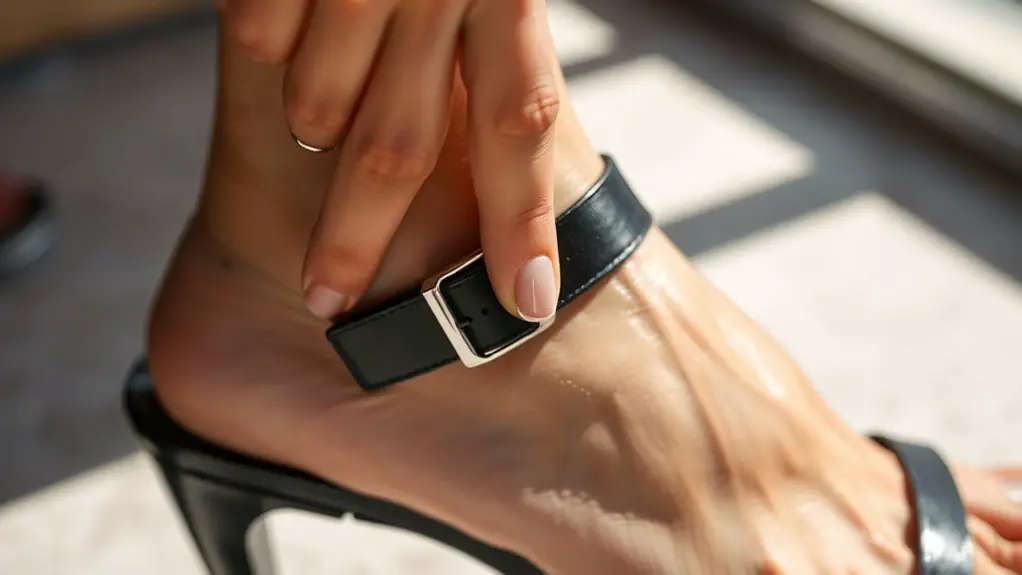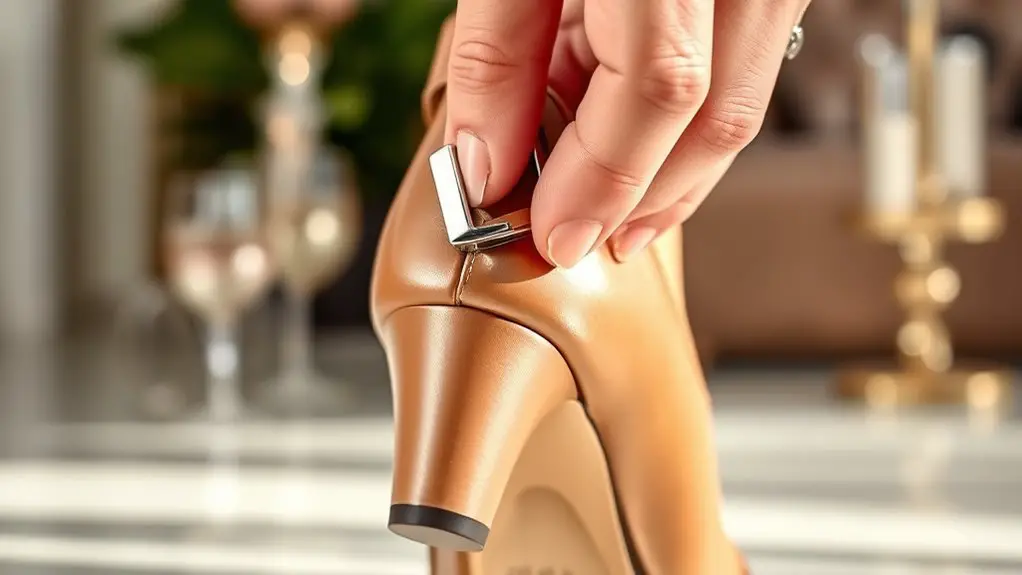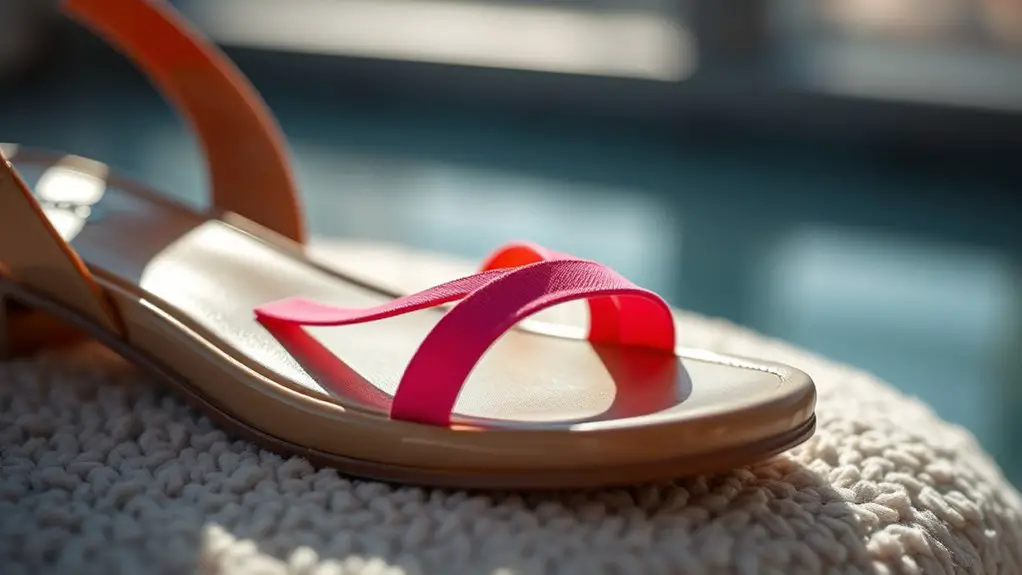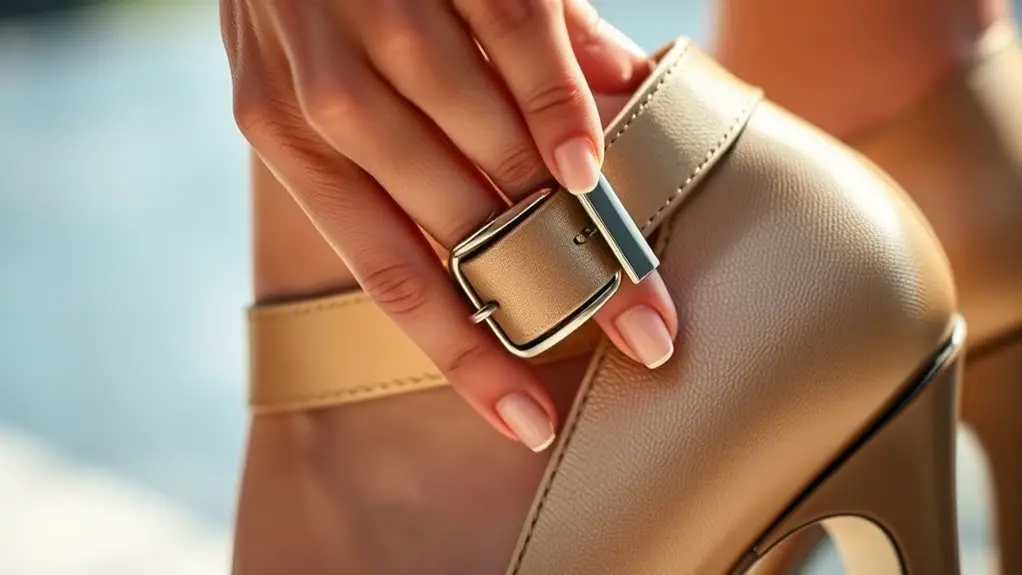To tighten loose heel straps for a secure fit, first, assess the material and type of your straps. For adjustable ones, use the sliders or buckles to achieve a snug fit without pinching. If you’re dealing with elastic straps, pull them firmly but not excessively. For added security, consider using heel grips or adhesive pads to fill any gaps. If you’re still struggling, explore some clever hacks and professional options that can elevate your shoe game!
Assessing Your Heel Strap Fit

How do you know if your heel straps are fitting just right? It’s all about the balance between comfort and security. Start by examining the heel strap materials—are they soft yet durable, like neoprene or leather? These fabrics should cradle your heel without causing irritation. Next, take a strap length measurement. You want the strap to snugly embrace your foot without pinching or slipping. When you adjust the straps, make certain there’s minimal movement; you shouldn’t feel your heel lifting with each step.
A good fit means your heel should sit securely in the shoe’s cup, allowing for a natural gait. If you can slide a finger between the strap and your heel with ease, it’s likely too loose. Conversely, if you can barely fit a fingertip, it’s too tight. Achieving that perfect fit is essential for both performance and comfort, so take the time to assess!
Adjusting Adjustable Straps
While adjusting your heel straps may seem straightforward, the right technique can make all the difference in comfort and performance. Start by identifying the strap materials; some are elastic, while others are synthetic or leather. Understanding the material helps determine how much tension you can apply without causing damage.
Next, experiment with various adjustment techniques. For elastic straps, pull firmly but not excessively; you want a snug fit that still allows for some movement. If you’re working with synthetic straps, use the built-in sliders or buckles to achieve your desired tightness.
Using Heel Grips for Extra Security

A few strategically placed heel grips can greatly enhance your footwear’s fit and comfort, especially if you’re struggling with slipping or instability. There are various heel grip types to choose from, including gel, foam, and adhesive options. Gel grips offer a soft cushion, while foam grips provide a firmer hold. Adhesive grips stick directly to the shoe, ensuring they stay in place.
For effective installation, start by cleaning the heel area to remove any dirt or oils. Then, peel off the backing from the grip and carefully position it at the back of the shoe, aligning it with your heel for maximum effect. Press firmly to secure it, allowing it to bond properly. Remember, a little adjustment can make a world of difference, giving you that snug, comfortable fit you’ve been seeking. With these tips, you can enjoy a more secure stride in your favorite footwear!
Adding Padding for Comfort
To enhance your comfort when wearing shoes, adding padding can be a game changer, especially for those long days on your feet. By incorporating the right padding materials, you can considerably improve your comfort levels and reduce fatigue.
Enhance your shoe comfort with padding to reduce fatigue during those long days on your feet.
Here are three effective options to evaluate:
- Foam Inserts: Lightweight and breathable, foam inserts conform to your foot’s shape, providing cushioning where you need it most.
- Gel Pads: These offer excellent shock absorption, making them ideal for high-impact activities. They mold to your foot and help alleviate pressure points.
- Fleece Liners: Adding fleece can create a soft barrier, enhancing warmth and comfort, particularly in colder months.
Selecting the right padding materials not only boosts your comfort levels but also helps maintain a snug fit, preventing your heel straps from digging in. Experiment with these options to find your perfect balance between comfort and support!
Employing Elastic Bands

After enhancing comfort with padding, you might find your heel straps still lacking in support. That’s where elastic bands come into play. These bands can tighten your heel straps effectively while providing flexibility. Choosing the right elastic band types is essential.
| Type | Pros | Cons |
|---|---|---|
| Braided Elastic | Durable, versatile | Can fray over time |
| Flat Elastic | Smooth, less bulky | Limited stretch |
| Knitted Elastic | High elasticity | May lose shape |
When employing elastic bands, keep elasticity considerations in mind. Overly stretched bands may weaken and lose their grip. Measure the length needed to achieve a snug fit without compromising comfort. By integrating elastic bands into your heel strap setup, you’ll enjoy a customized, secure fit that enhances your footwear experience.
Trying Shoe Inserts
While you might think heel straps are the sole element affecting comfort, trying shoe inserts can greatly enhance your overall fit. The right shoe insert types can provide additional support, cushioning, and stability, making your footwear more enjoyable to wear. Here are three popular options to evaluate:
- Gel Inserts: These provide excellent shock absorption, reducing pressure on your heels and arches, which can alleviate discomfort during long wear.
- Arch Support Inserts: Perfect for those with high or flat arches, these inserts help align your foot properly, distributing weight evenly for better stability.
- Memory Foam Inserts: Offering a custom fit, these molds to your foot shape, enhancing comfort benefits by minimizing friction and pressure points.
Utilizing Strap Keepers
Strap keepers can be a game-changer for securing heel straps and preventing them from slipping during wear. These handy accessories come in various strap keeper types, including loop, clip, and adhesive options. Each type serves a specific purpose, ensuring your heel straps stay snug without compromising comfort.
Using strap keepers offers numerous benefits. They help eliminate the constant readjustment of loose straps, allowing you to focus on your day instead of your footwear. Plus, they can enhance the overall aesthetic of your shoes, providing a neat, polished look.
To utilize strap keepers effectively, choose the type that suits your footwear style and strap material. For instance, clip keepers are perfect for thicker straps, while adhesive keepers work well with thinner ones. By incorporating strap keepers into your shoe routine, you’ll enjoy a secure fit and improved confidence in every step you take.
Securing With Safety Pins
If strap keepers aren’t your style or you need a quick fix, safety pins can provide an effective solution for securing heel straps. Using safety pins might feel unconventional, but with the right safety pin techniques, you can achieve reliable strap reinforcement.
For a quick fix to loose heel straps, safety pins offer an unconventional yet effective solution.
Here’s how to get started:
- Identify the Loose Area: Pinpoint where the heel strap feels too loose, usually near the ankle for ideal support.
- Choose the Right Safety Pin: Opt for a sturdy safety pin that can handle the tension without bending or breaking.
- Secure the Strap: Insert the safety pin through the strap and shoe material, ensuring it’s tight enough to hold but not so tight that it damages the material.
Professional Shoe Repair Options
When your heel straps need more than just a quick fix, seeking professional shoe repair options can be a game-changer. Skilled cobblers employ advanced shoe repair techniques to guarantee your heels fit securely and comfortably. They can assess the damage, whether it’s a loose strap or worn-out material, and recommend the best course of action.
Professional services might include reinforcing the straps with stronger materials, adjusting the fit, or even replacing components entirely. They have access to specialized tools and high-quality materials that many DIY methods simply can’t match.
Before you toss those beloved heels aside, consider visiting a local shoe repair shop. You’ll not only save money in the long run but also extend the life of your footwear. Trusting an expert with your cherished shoes helps maintain their elegance and functionality, giving you peace of mind with every step you take.
Frequently Asked Questions
Can I Tighten Heel Straps on Sandals and Flip-Flops?
Sure, you can tighten those heel straps! After all, who wouldn’t want to flaunt the latest fashion trends without tripping? Just check the strap materials—some adjust easily, while others might require a bit of finesse.
Are There Specific Tools Needed for Strap Adjustments?
For strap adjustments, you don’t need fancy tools; often, a simple screwdriver suffices. Depending on heel strap types—like buckle or slide—you might also use pliers or scissors. Always check for compatibility before starting adjustments.
How Often Should I Check My Heel Strap Fit?
You should check your heel strap fit regularly, ideally before each use. Consistent heel strap maintenance guarantees peak fitting, keeping your gear secure and comfortable. Regular adjustments prevent slippage and enhance overall performance during activities.
Will Tightening Straps Affect Shoe Comfort?
Tightening those straps can dance a fine line between snugness and comfort. While you’ll achieve a secure fit, keep in mind that too much pressure might compromise heel strap comfort. Finding the right balance is key.
Can Loose Heel Straps Cause Blisters?
Loose heel straps can definitely lead to blisters. When straps aren’t secure, friction increases, especially with certain materials. For blister prevention, make certain straps fit snugly without compromising comfort, allowing you to enjoy your adventures worry-free.



